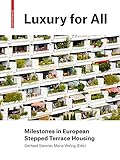Luxury for All : Milestones in European Stepped Terrace Housing / ed. by Gerhard Steixner, Maria Welzig.
Material type: TextPublisher: Basel : Birkhäuser, [2020]Copyright date: ©2020Edition: with noumer. colored illusDescription: 1 online resource (464 p.)Content type:
TextPublisher: Basel : Birkhäuser, [2020]Copyright date: ©2020Edition: with noumer. colored illusDescription: 1 online resource (464 p.)Content type: - 9783035618846
- 9783035618877
- online - DeGruyter
- Issued also in print.
| Item type | Current library | Call number | URL | Status | Notes | Barcode | |
|---|---|---|---|---|---|---|---|
 eBook
eBook
|
Biblioteca "Angelicum" Pont. Univ. S.Tommaso d'Aquino Nuvola online | online - DeGruyter (Browse shelf(Opens below)) | Online access | Not for loan (Accesso limitato) | Accesso per gli utenti autorizzati / Access for authorized users | (dgr)9783035618877 |
Browsing Biblioteca "Angelicum" Pont. Univ. S.Tommaso d'Aquino shelves, Shelving location: Nuvola online Close shelf browser (Hides shelf browser)
Frontmatter -- Contents -- Introduction -- The Potential of the Green City -- The Invention of Stepped Terrace Housing -- “Sundecks for All” — La Grande Motte -- Milestones in European Stepped Terrace Housing -- Autonomous Districts -- Olympic Village, Munich -- Alt-Erlaa Residential Park, Vienna -- Along the Edge -- St. Peter Housing Estate, Graz -- Koseze Housing Estate, Ljubljana -- Heinz-Nittel-Hof, Vienna -- Shaped by Traffic -- Hadikgasse Residential Complex, Vienna -- Alexandra Road Estate, London -- Autobahnüberbauung Schlangenbader Strasse, Berlin -- Density in Block Grids -- Inzersdorfer Strasse Residential Complex, Vienna -- Wohnen Morgen Wien -- Inner-City Hybrids -- Brunswick Centre, London -- La Serra, Ivrea -- The Return of Stepped Terrace Housing -- Author Biographies -- Index of Names -- List of Illustrations
restricted access online access with authorization star
http://purl.org/coar/access_right/c_16ec
Das Terrassenhaus entspricht als Bautyp modernen Wohnbau-Anforderungen: es ist ökonomisch und bietet bei geringem Bodenverbrauch hohen Wohnkomfort mit Terrasse und Garten. Populär geworden mit den sozialen Bewegungen in den 1960er Jahren, geriet es mit der fortschreitenden Erosion der Idee von Gesellschaft wieder in Vergessenheit und wurde gar als Bausünde abqualifiziert. Doch die anhaltende Bewohnerzufriedenheit und die ökologischen Vorteile eines begrünten Hauses machen das Terrassenhaus mehr denn je attraktiv. Die im Buch untersuchten Bauten sind heute nicht nur architektonische Ikonen; man kann auch von ihnen immer noch lernen, was der Wohnungsbau heute braucht. Ein Vertreter dieses Bautyps war Harry Glück, dessen Plädoyer für die grüne Stadt hier in Teilen abgedruckt wird.
The stepped terraced house is a type of building that meets modern housing requirements: it is economical and offers ample living space with the comfort of terrace and garden. Rising to popularity with the advent of new social movements it was forgotten with the progressive erosion of the new ideas of society and relegated them to obscurity or even to their disqualification as eyesores. Yet the enduring satisfaction of residents and ecological advantages of green houses make terraced housing as attractive as ever. The buildings studied in the book are not only architectural icons today; even today, one can still learn from them about what residential buildings need. One proponent of this building style was Harry Glück; part of his text pleading the case for a green city is printed here.
Issued also in print.
Mode of access: Internet via World Wide Web.
In English.
Description based on online resource; title from PDF title page (publisher's Web site, viewed 27. Jan 2023)









